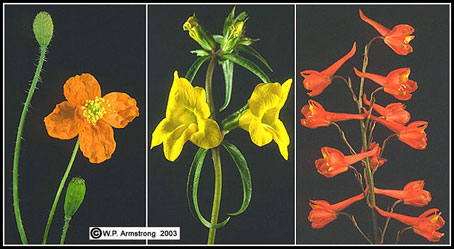The 10th largest fire in modern California history burned approximately 160, 557 acres – more than twice the size of Disneyland – in less than 3 months. The fires leave residents of La Cañada Flintridge, Glendale, Acton, La Crescenta, Pasadena, Littlerock and Altadena, Sunland and Tujunga with little peace of mind.

While Angelinos can be thankful the heavy rainfall of October 13th contained the fire, the rainfall also serves as a reminder about the dangers of erosion on desiccated slopes. While our ecosystems appear destroyed after expansive fires, great value exists on a burnt slope. Taking smart action to restore slopes now can prevent erosion, as well as future fires.
Expect Immediate, Unfamiliar Flowers
Despite plants having burned to the ground, their root systems are likely still intact and potentially substantial. These root systems can hold the structure of a slope together.

Some of the most common and valuable plants with a network of slope-protecting roots are Chamise, Coyote Bush, Mahogany, and Sumac. The stumps of these plants, among others, will immediately and aggressively sprout following the first rains. These sprouts will begin to provide coverage over the bare earth, creating habitat for insects, birds, and rabbits.
Unfamiliar wildflowers will also arise naturally after a fire. Some of the beneficial native wildflowers that spawn do so due to scarification, which promotes germination of dormant plant seeds beneath the surface of the soil. Scarification is any kind of “roughening up” of a seed that breaks the “seed coat” or hard barrier that prevented it from germinating without fire. Unfamiliar wildflowers will also appear because the environment has changed dramatically. Whether they needed more sun or more rainfall, they may now have conditions more favorable to their growth.
The post-fire season is an opportunity to delight in new wonders! It is also an opportunity to protect homes, towns, and wildspace from future devastation.
Prevent Future Fires with Effective Spacing
As stumps of natives sprout and grow, it is important to begin to increase the spacing between these larger shrubs and trees. Effective spacing will prevent bushes and shrubs from growing together. As connected foliage enables fires to spread quickly, spacing is an effective fire prevention strategy.
Properly placed plants will not need to be cut to the ground each year as part of mandatory fire clearance, as plants that form canopies do. Effectively spacing natives now can save between $2 and $4 per square foot in fire clearance expense! For a community that spent $93.8 million combating the fires, every penny counts.
Evade Slope Erosion with Native Foliage
Pause before hydroseeding or over planting non-native wildflowers onto your bare, burnt soil! Nature is actually quite effective at rejuvenating itself. Interrupting nature’s course by over-seeding bare areas with annuals can prevent permanent plants from taking hold of the soil. In the summer, dry slopes of these annuals remain and provide tinder for fire. In the winter when these same non-native annuals are dormant, they fail to provide the soil stabilization that prevents erosion.
In sharp contrast, the native wildflowers that come up after a fire will fade quickly as the area evolves and develops, making room for permanent, more fire resistant native plants. These permanent natives are much more effective slope stabilizers. Here again, planting natives will save money budgeted for annual fire clearance, as these wildflowers will not become persistent weeds and tinder, as annual non-natives do.
Fire Prevention and Slope Stabilization Checklist:
- Be quick now to evaluate the plant life on your slope, identifying what might be favorable bolstering its survival.
- Continue to be vigilant not to allow weeds and nonnatives out compete natives – it is the natives that ultimately will stabilize and protect your slope.
- As the landscape rejuvenates, keep distances between large shrubs and plants 15 to 20′ apart.
- Check drains, gutters and all water flow on the property, ensuring all is functioning properly. Do not aggravate a sensitive slope by allowing irrigation leaks or extra, unneeded watering.
- Consider some minor damming or post and boards as needed on the slope, not to stop the erosion, but to slow it down. The speed of water and mud movement is what can be very dangerous. Simply slowing its flow can save a home or a life.
- Consider sand bags now instead of later.
- If you are a current FormLA client, look for your little native wildflower seed package taped onto your Halloween pumpkin. Plant these seeds to support stabilization on our slopes!
- Educate your neighbors to protect them and yourself from erosion and fire hazards.
- Allow nature to take its course. Immediately planting annuals will only lead to an encore of this year’s fireworks.


